One of the most often overlooked basic necessities for serious prepping is the self-contained ESR (Emergency Survival Radio).
You might have been of the mindset that everything you need to know about emergencies in your area can be discovered with a couple swift moves of your index finger on you smartphone or tablet. Or on the breaking news channel on your nice high-definition flat screen TV.
And if for some reason those weren’t working, you could always resort to your reliable little AM/FM radio you keep somewhere in one of the kitchen cabinets. If it was good enough to pull in George Noory on ‘Coast to Coast AM’, in those wee hours of the morning when you couldn’t sleep and sat up sipping your hot cocoa waiting for the sun to rise, it should be good to go for some emergency update when you needed it, right?
Wrong. What if the emergency was a major power outage?
An EMP, or any number of catastrophic events which causes electricity to be the first casualty of the day?
If you don’t have a battery radio with fresh batteries, or the ability to recharge without plugging it in, you might not have it working good enough or at all, just when you need it the most. Like you’re hearing unusual explosion type sounds in the distance and you are trying to make a critical decision of bugging out or not, and need to know what‘s going on in your immediate area and the extent of the situation.
Batteries will usually be dead or too weak if they’ve been sitting too long in your radio. And standard small AM/FM radios have limited local range for the most part, and if the broadcasting origins are standard commercial stations, they simply might not be broadcasting any emergency details that would help you. Or they might be ’out of order’ themselves due to the emergency.
ESRs are intentionally purposed for off grid survival and not to be confused with a weather radio only. ESR’s perform some additional necessary functions in a bad situation.
Depending on the extent of the disaster scenario and what or who caused it, cell phone transmission capability might be also be dead. Governments now have terminal site kill switches for the servers, and cell towers are easily manually/computer disabled or sabotaged. They have been working on an internet ’kill switch’ and likely have it already. The G, of course, already has its own proprietary parallel internet and secured closed satellite communications systems, and doesn’t care if you can’t use yours. You need something better.
National Oceanic and Atmospheric Administration (NOAA) and other dedicated radio stations are ubiquitous and independent of standard commercial television and internet program transmissions.
Even after a major EMP event, if your ESR has the capability to reach out you’ll still likely find some broadcasts coming through somewhere to inform you of what is happening. This will be increased with advanced bandwidth and reception capabilities especially if your ESR receiver has short wave capabilities.
All ESRs Are Better than Nothing, but Some Are Much Better
An emergency radio usually means that it works in any emergency where standard equipment does not, because it doesn’t depend on the normal modes of operation like cell phones and other methods of info reception. It doesn’t need to be used through the standard power grid or even utilize batteries if they become dead and replacements are not available.
A good emergency radio will have at least two ways to power it. Most are battery operated but also have a hand crank dynamo/charger, but the better ones include all four power options:
- Basic AC outlet plug-in
- DC batteries
- A hand cranking power/charging dynamo
- Solar charging panels.
Now THAT’S what you call power back up! They usually have other options such as lights and USB ports to aid in your general survival needs.
So the best ESRs will have the above functions and also a wide band range, possibly even a short wave reception capability with a NOAA weather specific service, be relatively compact and light enough to fit in your bug out plans, AND…not break the equipment funding bank!
National Oceanic and Atmospheric Administration it’s a scientific action group that monitors all the weather and provides your television stations with the satellite photos they use for their own weather programs. A NOAA receiving radio is your best source of direct in progress weather information, even better than TV or standard radio weather forecasts, which broadcast on a prescheduled program because you can tune it only to instant live updates of your local areas anytime of the day.They are linked to dedicated local weather ‘spotters’ or equipment to determine on the spot wind speeds, rainfall, etc. And most radios with NOAA channels also have an option panic alert which sets off a beeping or loud alert tone if a bad storm, tornado watch or warning, or meteorite, volcano eruption, earthquake, UFO landings, attacking cannibal Zombie group, or escaped zoo lion is heading your way.
I’ve had dozens of various models and although there are many out there and some of you might have your own ideas or requirements, these choices represent my own opinion based on versatility, capability, and cost effectiveness. Yes, you can get some two hundred dollars plus models in weather radios because they have concert quality Bose style speakers and best reception antennas available, but a lot of these don’t have the above survival criteria. I can’t qualify it as a true ESR unless it at least has some sort of backup power supply and a NOAA alert option.
While there will always be differences of opinion depending upon subjective experience and other factors, this is just a list of what most survival people currently consider to be the most popular best bang for the buck.
But with technology changing so rapidly, who knows what better stuff is coming down the road? And if you don’t have one yet, at least get something now, and it never hurts to have another cooler one for back up later on when they come out with something that also has a built in satellite TV, tablet, and beer cooler.
1. Top Alert Emergency Solar and Crank Dynamo Radio
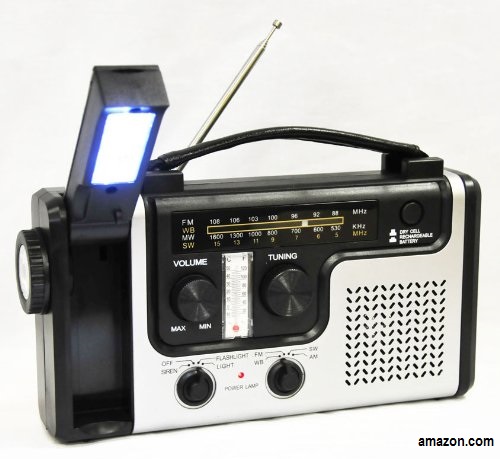
If you want an ‘almost’ pocket size compact ESR with no less than SIX ways to power/charge it, with a NOAA function and alert and flashlight AND for the least expense, this might be it, and it costs only 35 bucks!
2. Kaito KA500-600 series 5-way powered emergency AM/FM NOAA Short Wave Emergency Radio
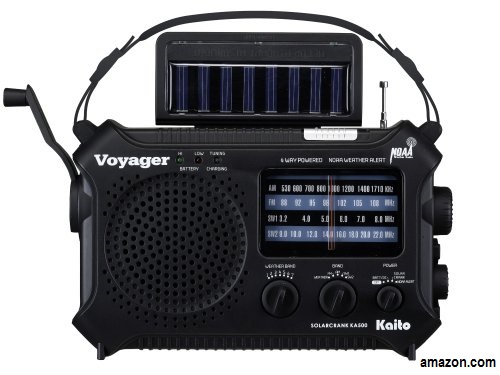
Kaito makes different versions from the 440 through 600 pro models from about $40 to over a $100. All nice radios with all the good stuff.
The biggest difference is in the digital or analogue display versions and some interesting options like SW reception. Some preppers think it’s better to have the analogue frequency display because it might be less susceptible to damage or failure to display.
3. C. Crane CC Solar Observer Emergency Radio
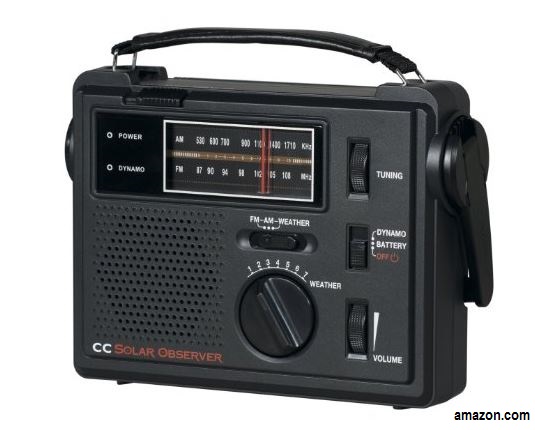
Crane radios are somewhat pricey but well established and there are several models including good short wave/Ham radios. This Solar Observer model is pretty reasonably priced and has what you need, if not anything additional for around 60 dollars.
4. Compact Kaito Vogager DX KA 360 Solar Crank AM/FM NOAA Weather Alert Emergency Radio
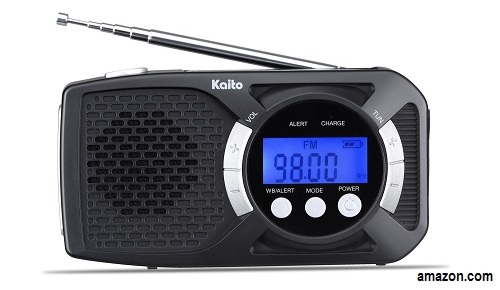
It’s hard to beat Kaito radios for bang for the buck and decent quality judging from their popularity growth in the last couple of years. This is their smaller pocket carry model with multiple features for its size like a solar panel it can run off directly without batteries. And it has a stand-by mode that automatically starts the radio message if the government is issuing one of those emergency alerts you sometimes hear over standard broadcasts as a ‘test’ with that raspy bleep noise. Can’t beat it for around 30 bucks.
5. Swiss+Tec ST84500 BodyGard Platinum
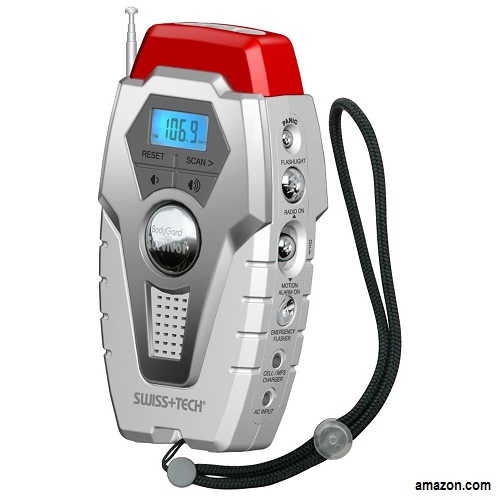
This is the ’Swiss Army Knife’ of ESRs, and one of the lightest and most compact models with good additional function we’ve come across. If you must have one for minimalist use only due to you absence of a non-permanent BOL or to carry in a solo back pack bug out scenario. This would be a good one to have for all its additional utility for around 40 bucks on E-bay or Amazon.
Again, you can search the Web and see dozens of different ESR models to pick the one that most suits you. And there are decent big brand names like Midland and Cobra mainly known for their compact two-way communications radios sold in Home Depot and elsewhere, but they also make NOAA weather alert and perhaps by now they have an ESR model.
And there are even some dirt cheap ones with NOAA service for under 15 bucks which are better than nothing, so check them out, read the reviews, and get one you like that best suit you and your situation. There’s really no excuse not to have a dedicated ESR these days. Once you get used to using it for direct weather forecasts and alerts in your area, you’ll appreciate it even more.
We always take a lot for granted in our lives. But catastrophic disasters you never expected–and were not prepared for–will always derail that train of complacency and normalcy bias the hard way for you. You won’t believe how lonely and frightening it will be when you don’t have a clue about what’s immediately going on in the world around you when the S finally does HTF.
This article has been written by Mahatma Muhjesbude for Survivopedia.





























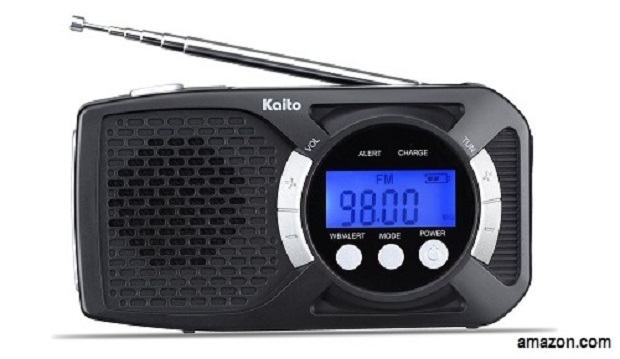













































I bought a $50.00 Kaito 500 and it was junk! After a couple of months the solar charger was inop and the warranty had expired. The ordered AC adapter never came.
The Realistic DX -100 would be good to have on hand for S/W because it uses tubes instead of transistors. (EMP proof) You can find them on eBay for about $75.00. Be sure to get the antenna for it.
Great stuff Guys. Thanks for the research and recommendations. Even if we only use this stuff on a day camp to the beach, it’s always good for our peace of mind to be prepared.
Bert
Thanks for the information, very helpful, would like to know your thoughts on the best 2 way radios for emergencies
Thank you for the article! Can you write one regarding the best Ham radios? I am looking into those, and would love more information and advice.
Thank you!
Ham radios will not do you much good till you get a lic go to arrl.org. for more info
What is the reception like on these radios? I have a Kaide that came with a bunch of batteries that I bought and its reception is poor. For sure, I am looking for a good emergency radio with all the bells and whistles.
Check out the Eaton (Grundig) “Scorpion” for abut $50 at Walmart.
I have bought a few of these little cube radios over the last few years, for me and for friends. They appear to be made by the same company but have different branding on them. The ones I recently bought are by Kaito. They can be charged by solar and crank, and are surprisingly sensitive and loud. They have AM/FM/WX bands and a headphone jack. No aux power input, though. Their biggest advantages are low price (currently only $15); decent (enough) performance; and small size. Plus, they run for quite awhile on a small amount of cranking or sitting in the sun. These are no-brainers — they are inexpensive enough so that you can stock up on a few, even if you already own a more expensive ESR with more features. It’s always smart to have backups for the essential items.
http://amzn.to/1IpMmZm
I have a c.crane.com CC Radio 2E that has am/fm/ 2 meter ham/ wx; It receives very well in a poor reception area. $170.
None of these receivers are capable of sideband reception.
Ben, the article mentioned the Kaito 600 series Voyager which has Short Wave reception capabilities.
I was referring to sideband shortwave. The emergency ham bands in that range transmit exclusively on sideband. Regular shortwave broadcasts are of little use in an emergency. http://advancedsurvivalguide.com/2010/09/08/the-survival-shortwave-radio-things-you-need-to-know-before-you-buy/
In addition to a sideband shortwave receiver, an analog police scanner would be preferable, IMO, to any of the wind-up emergency radios on the market now.
I’m sorry but none of these radios will work post EMP.
Detonation of a high altitude electromagnetic pulse (HEMP) will not just knock out the power grid, but will fry every piece of electronic circuitry in EVERY product…radios, cell phones, automobiles, aircraft, computers, everything. And it is not even known if simple C, AA and AAA batteries will survive. The only exception is if the item or items are proberly shielded in a specially designed hardened container or Faraday Cage. Galvanized trash cans sealed with duct tape, reflective mylar baggies and other crazy homemade contraptions will NOT work. I have emergency radios in all of my bugout bags, and they should perform perfectly well after your average run of the mill disaster. However, an EMP/HEMP is a game changer of the highest magnitude.
You are saying there’s absolutely NO other way to avoid utter, complete, total, destruction of all electrical items other than putting them in a ‘specially’ designed hardened container or Faraday cage’ because No radios will work post EMP? None? Zip? Nada?
That’s right…won’t work. However, if you can find an old (1930s/1940s) vacuum tube radio or an old OEM radio (pre-1948) in an old Desoto, they may still work because NO electronic circuitry is on-board. You don’t have to take my word for it. Look up “National Geographic Electronic Armageddon” (https://www.youtube.com/watch?v=Q9z4EnE9baU), and watch the video. Successful detonation of a HEMP over Omaha at about 200 miles up would knock out the US from coast to coast, destroying anything electrical or electronic. That would mean the end of the world as we know it (TEOTWAWKI)…90% of the population would be dead within a year. Also, do not confuse a massive solar coronal mass ejection with an EMP. As long as your radio is not plugged in to the electrical network and/or has batteries, it should still work. The grid itself, however, could be destroyed or greatly damaged…some areas more affected than others. Regardless, the bottom line is: if the entire US electric grid goes down and stays down for more that two weeks, it is not going to come back on. If you have solar power, at the very least, all the circuitry in your power inverter would be fried; the jury is still out on whether or not the photo-voltaic cells on the panels themselves would survive. Any way you cut it, it is a bad situation. Thanks for asking.
Kent, a Faraday Cage and a galvanized steel trash can with lid (grounded, of course) should be equal in effect to shield from an EMP. After all, what you are looking for is a shunt for EMP/RF to ground. I would ground the lid and body together with #14 stranded wire and the body grounded with same wire to a real ground rod (4 to 6 ft.) with good grounding/coupling techniques.
One should prepare for an EMP.
Store at least some of your important electronics in a Faraday cage.
If you have a microwave oven, put your electronics in that, batteries and all. A microwave oven IS a Faraday Cage.
I am a Ham Radio Operator, licensed of course. Recently I have read and viewed info about the Tesla Generator. Some say it’s a scam, or it may not work in case of an EMP event. Solar may be more reliable, but is costly. I do have a Innovage “Outdoor” with AM/FM/Weather Band, Hand Crank Dynamo, Rechargeable Batteries, and 6V Chrgr. Not sure if it’s susceptible to EMP? Also have an old Allied Shortwave Receiver, tube type, w/sideband capability, w/8 band selection, 110V. Also various other mobile units, 12 volts, 2, 10, and 11 Meters, and a 2 Meter Handheld w/rechargeable batt’s. How to power all of these is my concerns? And to protect from EMP?
Look-up Stirling Power Generator. It will work even after a HEMP. It uses sun light to make it work and is NOT electronically operated. It is mechanically or powered by the sun.
You didn’t list the name of the first radio.. ? How can I buy it if I don’t know the name
Just type in what is printed after the 1. Top Alert Emergency Solar and Crank Dynamo Radio, that IS the name of the radio. Typing that onto your search engine will take you too that exact radio on Amazon.
Has anyone ever had the Midland “Base Camp” XT511? It includes a USB port to charge phones, etc. Mine, however, does not charge anything unless it is plugged in (using AC adapter). Wonder if this is a flaw and needing to be replaced or if that is the way that particular radio works. Seems to defeat the purpose of the dynamo. I’ve called and asked, but am supposed to call back again. Any thoughts?
You can make it as big as you want it to be. (Stirling Power generator)
This is awesome! I hope they will work. I am very much interested to get one. How much would it cost?
The best by far is not on the list and is called Etón Hand-Crank Two-Way Survival Radio.
Obviously an EMP would be catastrophic since I don’t believe there are any countermeasures or backup resources stockpiled and ready to be easily and quickly replaced. How do we begin the boot back up? We cannot just sit there with our fingers in our ears, we must design, plan, engineer special inventories of specific components needed to replace the damaged circuitry.
Is there a plan in place outlining an emergency strategic recovery system to immediately commence repairs, replacement and recovery of our power grid? If not, we are sitting ducks. How to prepare in the event of an EMP is as critical as surviving one in the long-term especially in urban areas with high density populations.
The thing to do is form a special committee ro research, study to examine ways to implement any countermeasures we can to affect a recovery of America’s power grid. Also, an EMP would not be controlled and would affect other nations!
An EMP will fry every piece of electronic equiptment made, unless it’s properly shielded in a Faraday cage, ” a microwave oven will do”. or a cardboard box, covered with tinfoil, completely covered with no seams. Then the object to be protected gets placed inside with some additional foam or cardboard, and closed up and refoialed. I don’t understand why some think these radios will survive, they will all be fried. Some cars will be ok because they are insulated by rubber tires. But it’s iffy at best, the electronics could still suffer damage.
Interesting ideas – I was enlightened by the facts ! Does anyone know if my assistant might grab a sample CA FTB 3522 form to type on ?
I’m a single disabled Mom and I’m trying to find out where I can get cheap solar and wind up radios and flashlight or possibly Free? Please email me back and God Bless!
Sharing some Best Emergency Radio in 2017
https://www.walkietalkiecentral.com/best-emergency-radio/
A usefull emergency radio should have single sindeband and all shortwave bands.
so you can receive not only bc a wx radio. with such a radio everyone can listen to ham operators, aircrafts, USAF emergency action messages (EAMs) and.. and.. vy usefull more.
Couple of points.
In the comments regarding EMP, keep in mind that there are a multitude of factors that affect whether a piece of equipment survives or not … distance, conductor length, circuitry, shielding, orientation, mountains in the way, parking garage … WAY too many to list. It is an oversimplification to say that nothing will survive … and I think Mahatma was sort of sarcastically ribbing toward that end in the comments.
One of the very most important factors for this type of radios is that you buy a Public Alert Certified All Hazards Radio. Just because a radio receives NOAA channels IS NOT the same thing as being Public Alert Certified. Please learn the difference because they have many important features that make them orders of magnitude more effective above and beyond receiving the NOAA channels.
I have bought two different models of Kaito radios and both were junk. Horrible reception except for only the closest and strongest signals. that is why they are in 30- 40 range. Garbage.
As ham radio OP and former air force radio OP i’am “dealing” with emergency radio since around 40 years. Here in europe hf will be very usefull, but only when when SSB is included. To watch ham radio and communications like avioncs radio. All receivers today are batterie operated and can be powerd form external sources. So the built in handcraft generator is not the most significant what an emcom radio should have. My own priorities are: HF SSB and low pwr consumption.